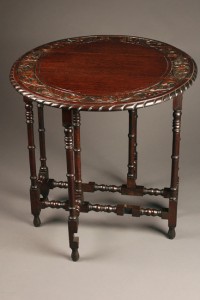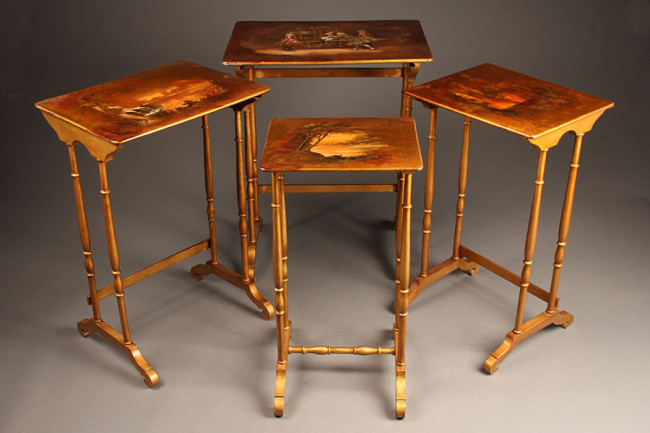In many ways, our collection of antique occasional tables embodies some of the most versatile pieces we have in our shop. Also known as side tables or accent tables, these furnishings are used in many different ways: night stands, beside chairs or sofas, quick catch for items in an entryway, appropriately scaled pieces for filling a small space, drinks or tea tables, collections display, holding a lamp, usable surface between two chairs… the list goes on and on. They come in an array of styles and sizes and in common or unusual shapes – rectangle, round, oval, square, octagon, hexagon, and even kidney-shaped! Some have drawers and/or doors, some are part of a nesting table set, and some can be adjusted from small to smaller. We have highlighted some of our favorite pieces in our inventory to offer a sense of the variety found in antique accent tables:
 English Gate Leg Drop-leaf Table: Hard-carved decorative elements on the drop-leaf round top are only the beginning of what makes this occasional table so wonderful. Circa 1890 and made of oak and quarter sawn oak, the piece also features lovely turned legs, two of which move depending upon the use of the drop leaf. The edge of the table top is carved in a band of acanthus leaves and finished with a scalloped edge. The drop-leaf presents sizing options, allowing it to be used in many different directions and spaces. You can have both leaves up, one up at a time, or both down – whatever suits your needs. A bit of history: long, narrow tables like this are often referred to as Sutherland tables, named after Harriet Sutherland, the Duchess of Sutherland and a good friend of Queen Victoria.
English Gate Leg Drop-leaf Table: Hard-carved decorative elements on the drop-leaf round top are only the beginning of what makes this occasional table so wonderful. Circa 1890 and made of oak and quarter sawn oak, the piece also features lovely turned legs, two of which move depending upon the use of the drop leaf. The edge of the table top is carved in a band of acanthus leaves and finished with a scalloped edge. The drop-leaf presents sizing options, allowing it to be used in many different directions and spaces. You can have both leaves up, one up at a time, or both down – whatever suits your needs. A bit of history: long, narrow tables like this are often referred to as Sutherland tables, named after Harriet Sutherland, the Duchess of Sutherland and a good friend of Queen Victoria.
 Set of Four French Nesting Tables: Circa 1900, this lovely set features vernis Martin-style embellishments. Vernis Martin is a type of lacquer-like finishing made famous by French brothers Guillaume and Etienne-Simon Martin in the 18th century. Meant to mimic Eastern Asian lacquered pieces, the furniture was decorated with social or romantic scenes of the times. In this set, a different scene has been painted over the polychrome faux gold-leaf finish of each table. As these tables were meant to be functional, a lacquer was then applied to the pieces to protect the painted sceen. Nesting tables usually come in groups of two but can sometimes be as many as five to six. Sized to fit within each other, they can be used as a single table, tiered to offer an interesting look, or brought out separately as multiple occasional tables.
Set of Four French Nesting Tables: Circa 1900, this lovely set features vernis Martin-style embellishments. Vernis Martin is a type of lacquer-like finishing made famous by French brothers Guillaume and Etienne-Simon Martin in the 18th century. Meant to mimic Eastern Asian lacquered pieces, the furniture was decorated with social or romantic scenes of the times. In this set, a different scene has been painted over the polychrome faux gold-leaf finish of each table. As these tables were meant to be functional, a lacquer was then applied to the pieces to protect the painted sceen. Nesting tables usually come in groups of two but can sometimes be as many as five to six. Sized to fit within each other, they can be used as a single table, tiered to offer an interesting look, or brought out separately as multiple occasional tables.
 Pair of Petite Antique Louis XVI Side Tables: The kidney shape of these pieces make for an interesting design element in a space. The marble tops are adorned with bronze galleries (the rim around the periphery), a common pairing with a functional origin. To avoid having the legs of a small piece bear the weight of a slab of marble, a thin pieces of marble would be used to cover a wooden top and then trimmed with a gallery. The look allowed the weight to be reduced while offering an interesting style element. Along with the galleries, the unique kidney shape and the turned, tapered, fluted legs are common for Louis XVI furnishings. The style was revived after WWI, during the opulent roaring 20s when quite a few beautiful pieces were produced in Europe and America.
Pair of Petite Antique Louis XVI Side Tables: The kidney shape of these pieces make for an interesting design element in a space. The marble tops are adorned with bronze galleries (the rim around the periphery), a common pairing with a functional origin. To avoid having the legs of a small piece bear the weight of a slab of marble, a thin pieces of marble would be used to cover a wooden top and then trimmed with a gallery. The look allowed the weight to be reduced while offering an interesting style element. Along with the galleries, the unique kidney shape and the turned, tapered, fluted legs are common for Louis XVI furnishings. The style was revived after WWI, during the opulent roaring 20s when quite a few beautiful pieces were produced in Europe and America.
Click here to see our complete inventory of antique occasional tables. We are sure you will find many options for your home décor needs. We are always happy to answer questions, so give us a call at 1-800-860-0109.
